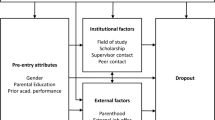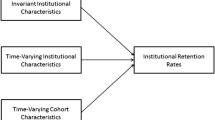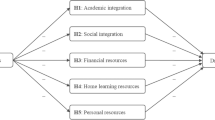Abstract
In the past two decades, although access to higher education for American students has improved, student persistence in 4-year institutions is far from assured. There have been a number of research studies on student persistence/dropout in higher education, but most have focused on the characteristics and behavior of students as illustrated by the “student-centered research tradition”. This study focuses on what institutional characteristics contribute to conditions that reduce student dropout risks. By analyzing longitudinal and hierarchical data, this research proposes and tests a multilevel event history model that identifies the major institutional attributes related to student dropout risk in a longitudinal process. Evidence indicates that institutional expenditure on student services is negatively associated with student dropout behavior. Implications of the results for institutional practices and future research are discussed.

Similar content being viewed by others
Notes
The IPEDS data for this study are from the Delta Cost Project (http://www.deltacostproject.org), which provides a user-friendly interface (Schneider 2010).
The low high school GPA ranges from D− to B−, middle GPA ranges from B to B+, and high GPA ranges from A− to A.
Following the work of John Smart (Smart and Umbach 2007) and Paul Umbach (Umbach and Milem 2004), this study utilizes John Holland’s concept of six disciplinary clusters for recoding college student majors in the first year. Detailed discussion about the categorization can be found in Smart and Umbach (2007).
Following previous work (Zhang and Ness 2010), this study used the interpolation method for imputing missing values in panel data.
This range does not include the estimated probability for an outlier institution, which will be discussed later in the paper.
There are two exceptions. Results demonstrate that the relationship between Pell grants and dropout risks and between unsubsidized loans and dropout risks are significantly stronger in the fourth year or sixth year than in the first year (results are available upon request). It is questionable how much significance should be attached to these interactions because there is a small level of risk remaining by this late stage of a college career, which may lead to imprecise estimates.
Student service, according to the definition in IPEDS, is a functional expense category that includes expenses for activities whose primary purpose is to contribute to students’ emotional and physical well-being and to their intellectual, cultural, and social development outside the context of the formal instructional program (NCES 2002).
References
Allison, P. D. (2001). Missing data. Thousand Oaks: Sage Publications.
Astin, A. W. (1993). What matters in college? Four critical years revisited. San Francisco: Jossey-Bass.
Bahr, P. R. (2009). Educational attainment as process: Using hierarchical discrete-time event history analysis to model rate of progress. Research in Higher Education, 50(7), 691–714.
Baird, L. L. (1988). The college environment revisited: A review of research and theory. In J. C. Smart (Ed.), Higher education: Handbook of theory and research (Vol. 4, pp. 1–52). New York: Agathon Press.
Barber, J. S., Murphy, S., Axinn, W. G., & Maples, J. (2000). Discrete-time multilevel hazard analysis. Sociological Methodology, 30, 201–235.
Bean, J. P. (1983). The application of a model of turnover in work organizations to the student attrition process. Review of Higher Education, 6(2), 129–148.
Berger, J. B., & Milem, J. F. (2000). Organizational behavior in higher education and student outcomes. In J. C. Smart (Ed.), Higher education: Handbook of theory and research (Vol. XV, pp. 268–338). New York: Springer.
Chen, R. (2008). Financial aid and student dropout in higher education: A heterogeneous research approach. In John. Smart (Ed.), Higher education: Handbook of theory and research (Vol. XXIII, pp. 209–240). New York: Springer.
Chen, R., & DesJardins, S. L. (2008). Exploring the effects of financial aid on the gap in student dropout risks by income level. Research in Higher Education, 49(1), 1–18.
Chen, R., & DesJardins, S. L. (2010). Investigating the impact of financial aid on student dropout risks: Racial and ethnic differences. Journal of Higher Education, 81, 179–208.
DesJardins, S. L., Ahlburg, D. A., & McCall, B. P. (1999). An event history model of student departure. Economics of Education Review, 18(3), 375–390.
DesJardins, S. L., Ahlburg, D. A., & McCall, B. P. (2002). Simulating the longitudinal effects of changes in financial aid on student departure from college. Journal of Human Resources, 37(3), 653–679.
Ehrenberg, R. G., & Zhang, L. (2005). Do tenured and tenure-track faculty matter? Journal of Human Resources, 40(4), 647–659.
Gansemer-Topf, A., & Schuh, J. (2006). Institutional selectivity and institutional expenditures: Examining organizational factors that contribute to retention and graduation. Research in Higher Education, 47(6), 613–642.
Hu, S., & St. John, E. P. (2001). Student persistence in a public higher education system: Understanding racial and ethnic differences. Journal of Higher Education, 72(3), 265–286.
Kim, D. B. (2007). The effect of loans on students’ degree attainment: Differences by student and institutional characteristics. Harvard Educational Review, 77(1), 64–100.
Miner, J. B. (2002). Organizational behavior: Foundations, theories, and analyses. Oxford: Oxford University Press.
National Center for Education Statistics. (2002). Integrated postsecondary education data system, 2002. Available from National Center for Education Statistics web site, http://www.nces.ed.gov/ipeds. Also available from http://nces.ed.gov/ipeds/glossary/.
National Center on Education Statistics (2005). College persistence on the rise? Changes in 5-year degree completion and postsecondary persistence rates between 1994 and 2000. (NCES Publication No. 2005156), Author, Washington, DC.
Pascarella, E., & Terenzini, P. (2005). How college affects students: A third decade of research. San Francisco: Jossey-Bass.
Paulsen, M. B., & St. John, E. P. (2002). Social class and college costs: Examining the financial nexus between college choice and persistence. Journal of Higher Education, 73(2), 189–236.
Perna, L. & Thomas, S. (2006). A framework for reducing the college success gap and promoting success for all. Commissioned report for the national symposium on postsecondary student success: Spearheading a dialog on student success. National Postsecondary Education Cooperative.
Pfeffer, J. (1982). Organizations and organization theory. Massachusetts: Pitman Publishing Inc.
Pfeffer, J., & Salancik, G. (1978). The external control of organizations: A resource dependence perspective. New York: Harper and Row Publishers.
Price, J. L. (1977). The study of turnover. Ames: Iowa State University Press.
Raudenbush, S. W., & Bryk, A. S. (2002). Hierarchical linear models: applications and data analysis methods (2nd ed.). Newbury Park: Sage.
Rhee, B. (2008). Institutional climate and student departure: A multinomial multilevel modeling approach. The Review of Higher Education, 31(2), 161–183.
Rumberger, R. W., & Thomas, S. L. (2000). The distribution of dropout and turnover rates among urban and suburban high schools. Sociology of Education, 73, 39–67.
Ryan, J. F. (2004). The relationship between institutional expenditures and degree attainment at baccalaureate colleges. Research in Higher Education, 45(2), 97–114.
Schibik, T. & Harrington, C. (2004). Caveat emptor: Is there a relationship between part-time faculty utilization and student learning retention? Association for Institutional Professional Files, 91.
Schneider, M. (2010). Finishing the first lap: the cost of first-year student attrition in America’s four-year colleges and universities. Washington: American Institutes for Research.
Schuster, J. H. (2003). The faculty makeover: What does it mean for students? In E. Benjamin (Ed.), Exploring the role of contingent instructional staff in undergraduate learning (pp. 15–22). San Francisco: Jossey-Bass.
Singell, L. D. (2004). Come and stay a while: Does financial aid effect enrollment and retention at a large public university? Economics of Education Review, 23, 459–472.
Singer, J. D., & Willett, J. B. (2003). Applied longitudinal data analysis: modeling change and event occurrence. Oxford: Oxford University Press.
Smart, J.C., Feldman, K.A., & Ethington, C.A. (2006). Holland’s theory and patterns of college student success. In Commissioned report for the national symposium on postsecondary success: Spearheading a dialogue on student success. Washington DC: The National Postsecondary Education Cooperative.
Smart, J.C., & Umbach, P. (2007). Faculty and academic environments: Using Holland’s theory to explore differences in how faculty structure undergraduate courses. Journal of College Student Development, 48 (March/April), 183–195.
Thomas, S. L., & Heck, R. H. (2001). Analysis of large-scale secondary data in higher education research: Potential perils associated with complex sampling designs. Research in Higher Education, 42(5), 517–540.
Tinto, V. (1987). Leaving college: Rethinking the causes and cures of student attrition. Chicago: University of Chicago Press.
Tinto, V. (1992). Student attrition and retention. In B. R. Clark & G. R. Neave (Eds.), The encyclopedia of higher education (1st ed., pp. 1697–1709). Oxford, England; Tarrytown: Pergamon Press.
Tinto, V. (1993). Leaving college: Rethinking the causes and cures of student attrition. Chicago: University of Chicago Press.
Tinto, V., & Pusser, B. (2006). Moving from theory to action: Building a model of institutional action for student success. In Commissioned report for the national symposium on postsecondary success: Spearheading a dialogue on student success. Washington DC: The National Postsecondary Education Cooperative.
Titus, M. A. (2004). An examination of the influence of institutional context on student persistence at 4-year colleges and universities: A multilevel approach. Research in Higher Education, 45(7), 673–699.
Titus, M. A. (2006a). Understanding college degree completion of students with low socioeconomic status: The influence of the institutional financial context. Research in Higher Education, 47(4), 371–398.
Titus, M. A. (2006b). Examining the influence of the institutional context of four-year institutions on the timing of student attrition by socioeconomic status. Presented at the 2006 AIR annual conference.
Titus, M. (2006c). No college student left behind: The influence of financial aspects of a state’s higher education policy on college completion. Review of Higher Education, 29(3), 293–317.
Toutkoushian, R. K., & Conley, V. M. (2005). Progress for women in academe, yet inequities persist: Evidence from NSOPF: 99. Research in Higher Education, 46(1), 1–28.
Umbach, P. D., & Milem, J. F. (2004). Applying Holland’s typology to the study of differences in student views about diversity. Research in Higher Education, 45(6), 625–649.
Webber, D. A. & Ehrenberg, R. (2009). Do expenditures other than instructional expenditures affect graduation and persistence rates in American higher education? Working Paper. Cornell Higher Education Research Institute (CHERI).
Yamaguchi, K. (1991). Event history analysis. Newbury Park: Sage Publications.
Zhang, L., & Ness, E. (2010). Does state merit-based aid stem brain drain? Educational Evaluation and Policy Analysis, 32(2), 143–165.
Acknowledgments
This research is based upon work supported by the Association for Institutional Research, the National Center for Education Statistics, the National Science Foundation, and the National Postsecondary Education Cooperative under Association for Institutional Research Grant # RG10-119. Financial support is gratefully acknowledged. The comments from the anonymous reviewers are very constructive and are greatly appreciated.
Author information
Authors and Affiliations
Corresponding author
Appendix
Rights and permissions
About this article
Cite this article
Chen, R. Institutional Characteristics and College Student Dropout Risks: A Multilevel Event History Analysis. Res High Educ 53, 487–505 (2012). https://doi.org/10.1007/s11162-011-9241-4
Received:
Published:
Issue Date:
DOI: https://doi.org/10.1007/s11162-011-9241-4




